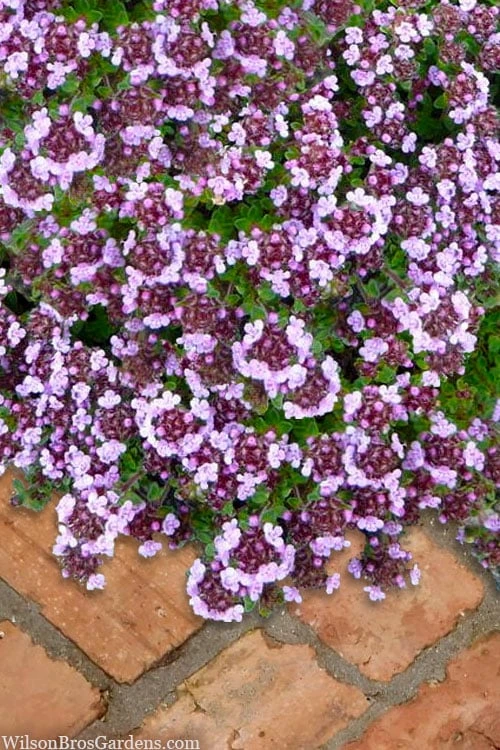Discover how this dual-purpose herb solves landscaping dilemmas while elevating your culinary creations

Product Highlights
- Pack Size: 5 Quart Pots
- Price: $48.98
- Growth Height: 2-4″
- Spread: 18″+
- Flower Color: Pink & Magenta
- Fragrance: Aromatic foliage
- Hardiness: Zones 5a-9b
The Groundcover Dilemma Solved
Every gardener knows the struggle: finding a plant that checks all the boxes for those tricky spaces between stepping stones, barren slopes, or under trees. Most solutions require constant weeding, look sparse for half the year, or can’t withstand occasional foot traffic. Artificial turf lacks charm, while mulch needs constant replenishment. The result? Compromised aesthetics and endless maintenance.
Enter Caborn Wine & Roses Creeping Thyme – a fast-growing evergreen that forms a dense mat of fragrant foliage crowned with summer-long pink blooms. Unlike ordinary groundcovers, this thyme variety serves double duty as a culinary herb, transforming your landscape into an edible masterpiece.
The Science Behind the Beauty
Physical Structure
This low-growing perennial forms a dense network of woody stems with tiny (1/4″) oval leaves. Its prostrate growth habit creates a living mulch effect, with stems rooting where they touch soil for natural propagation.
Chemical Composition
Contains thymol and carvacrol – natural compounds with antimicrobial properties. These essential oils give the foliage its characteristic fragrance and make it resistant to deer and most pests.
Growth Mechanism
Exhibits allelopathic tendencies, suppressing weed growth through root exudates. The dense foliage blocks sunlight to weed seeds while the shallow root system efficiently captures surface moisture.
How It Stacks Up Against Popular Groundcovers
| Feature | Caborn Thyme | Irish Moss | Sedum | Mondo Grass |
|---|---|---|---|---|
| Foot Traffic Tolerance | High | Medium | Low | Medium |
| Edible Value | Yes (culinary herb) | No | No | No |
| Flower Duration | 8-10 weeks | 2-3 weeks | 4-6 weeks | None |
| Water Needs | Low | High | Very Low | Medium |
Transformative Garden Moments
The Problematic Pathway
Initial State: Unsightly gaps between stepping stones collect weeds and mud after every rain.
Trigger: Guests comment on the messy appearance during a garden party.
Solution: Planting Caborn Thyme 10-12″ apart fills gaps within months, creating a fragrant, flowering path that withstands foot traffic while suppressing weeds.
The Barren Slope
Initial State: Erosion-prone hillside requires constant mulching and weeding.
Trigger: Heavy rains wash away another layer of mulch.
Solution: Mass planting at 15-18″ spacing creates a erosion-controlling mat that becomes denser each year, requiring no replenishment.
The Culinary Connection
Initial State: Separate herb garden requires frequent trips from kitchen.
Trigger: Abandoning recipes mid-prep to harvest herbs.
Solution: Using Caborn Thyme as border plantings near patios provides fresh seasoning within steps of outdoor cooking areas.
Gardeners’ Experiences
“After three failed attempts with other groundcovers, the Caborn Thyme filled my entire stone pathway in one season. The pollinators love it, and I love walking through the fragrance.”
– Marianne T., Zone 7a
“I use the leaves year-round for cooking – they have a more complex flavor than store-bought thyme. The winter foliage stays green enough for occasional harvests even in Virginia.”
– David R., Culinary Gardener
Why Caborn Wine & Roses Stands Apart
This exceptional creeping thyme variety delivers unparalleled value as both a low-maintenance groundcover and flavorful culinary herb. Its drought tolerance makes it ideal for water-wise gardens, while the extended bloom period provides exceptional pollinator support. Unlike ordinary thyme plants, the ‘Caborn Wine and Roses’ cultivar offers superior disease resistance and foot traffic tolerance, solving multiple landscaping challenges simultaneously.
For gardeners seeking evergreen groundcover plants that combine ornamental appeal with practical functionality, this 5-pack of quart-sized plants establishes quickly, creating flowering borders, living pathways, and edible landscapes with minimal effort. The fragrant foliage releases its aroma when brushed against, transforming ordinary garden spaces into sensory experiences.
